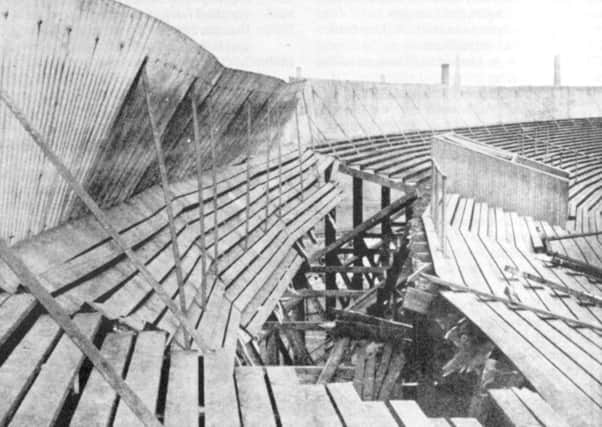On this day 1902: First Ibrox disaster


On the afternoon of 5 April 1902 a bumper crowd gathered at the then newly-built Ibrox Park in Glasgow to witness the Scotland national team face the ‘Auld Enemy’ for only the 31st time in their history.
Sadly, several hundred attendees would not be going home that evening. In fact, 26 wouldn’t be going home ever again.
Advertisement
Hide AdAdvertisement
Hide AdThe game had not long kicked off when shortly after 4PM a large section to the rear of the West Tribune Stand - estimated to have been holding just under half of the 70,000-strong crowd that day - collapsed, sending a tangled mass of humanity tumbling 45 feet through broken boards. The match was temporarily halted to allow the treatment of those injured, but play soon continued, the two teams battling it out for a 1-1 draw.
The final death toll was recorded as 26 with a further 587 injured. It was reported by The Scotsman at the time that rescuing the victims was a “work of great difficulty”.
Bobby Templeton’s first cap
Astonishingly, it was alleged that skilful Aston Villa winger Bobby Templeton was partly to blame for the tragedy. An investigation claimed he had been in possession of the ball at the time of the collapse and had caused vast numbers of spectators to rush forward in desperate attempts to catch a glimpse of the mercurial outside right dribbling the ball. It was Templeton’s first national cap, though the match was later declared void.
Aftermath
Rangers Football Club, the owners of Ibrox Park, and the Scottish Football Association were not subjected to any criminal investigations or civil actions following the disaster. However, doubts regarding the quality of the construction materials as chosen by the renowned Archibald Leitch led to the manufacturers being prosecuted for culpable homicide. The case was unsuccessful, though the disaster put an abrupt end to the future use of wooden terraces. The reputation of Archibald Leitch survived relatively unscathed and a fund-raiser was set up to compensate those who had lost loved ones.
Ibrox 1902 and the ‘Old Firm’
Rangers FC spent vast sums of money redeveloping their 3-year-old ground in a bid to prevent any such calamity from happening again. Several star players were sold in the process, leaving the door wide open for Glasgow rivals Celtic to notch up six consecutive league titles over the next decade.
Until the collapse, Rangers had been Scottish football’s most dominant side winning 4 titles in as many seasons between 1899-1902. It could even be argued that the power struggle which ensued provided the catalyst for the infamous ‘Old Firm’ rivalry and the rise of sectarianism.
Before the tragedy, Rangers were every bit as eager to beat local rivals Clyde and Third Lanark as they were Celtic, but when the latter claimed their sixth straight title at the end of season 1909/10, the assertion was made in the media that Rangers should be the ‘Scottish club’ tasked with putting a stop to the ‘Irish Catholics’ and their period of dominance. Rangers didn’t disappoint, the Ibrox side claiming the championship the following year. Average league attendances between the two sides almost doubled in the ten years after 1902.
Legacy
Speaking about the first Ibrox disaster in The Scotsman, Rangers club historian David Mason revealed his regret that the disaster appeared to be largely forgotten. “If you speak to most people today about the first Ibrox disaster, they look quite startled because they don’t realise there was another disaster. Sadly, it has been lost in the depths of time.
Advertisement
Hide AdAdvertisement
Hide Ad“We shouldn’t lose sight of the events of 1902, because it is an integral part of our history.”
Ibrox would be hit by fatal tragedies on two more occasions. In 1961 two people died as a result of a crush on stairway 13. The same stairway would leave 24 injured in 1969 before claiming the lives of 66 just two years later in what proved to be Britain’s deadliest stadium disaster until Hillsborough.